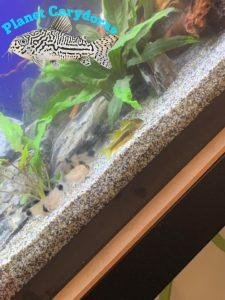
Species Summary
Before we continue into the guide it is important to mention that there are over 160 recognised species of Corydoras whilst there are still several hundred undescribed (These are given CW or C classifications such as CW010 “Gold Laser” Corydoras). As such, it is not the aim of this guide to give specific information for each species but a general guide that will begin to outline the knowledge required to keep these fish.
Corydoras are social bottom dwelling catfish. They are often referred to as Armoured Catfish and this is further emphasised by their name which has been borrowed from the greek words Kory (Helmet) and doras (Breastplate). They are also referred to as Cory cats, Corydoras catfish, and Cory fish. Corydoras are a peaceful species and will fit into the tanks of all levels of aquarists, beginner or advanced.
Scroll to the bottom for a helpful video guide that accompanies this guide!

Appearance and Size:
Corydoras Catfish will range in size from 1 inch to 3 inches (25mm to 80mm) in length although specific species may fall outside these limits.
Corydoras do not have scales as other fish do, instead their bodies are protected by bony plates that run along the length of its body. It has a flat underbelly that is adapted well to sit on a soft and sandy substrate. They use their horizontal pectoral fins to assist them to rest comfortably and upright on the substrate. Their dorsal fin is generally pointed and gives a sail like appearance leading down to a tail fin that can vary in size but will generally be forked.
The most recognisable feature of the corydoras is their barbels. These consist of three pairs of “whiskers” that they use to help them find food within the substrate.
Colouration will vary among species.
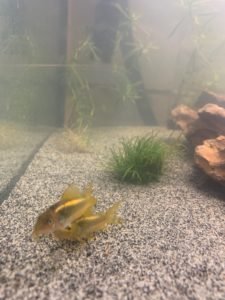
Habitat
- In the wild:
The Corydoras catfish can be found, in the wild, across a large area of South America from as far north as Trinidad to as far south as Northern Argentina. They populate the smaller streams and tributaries that run off of the larger rivers. The areas they can be found occupying will be predominantly sandy bottomed streams which compliments their foraging style of feeding.
- In the Aquarium:
In the aquarium, much debate is had over the substrate that should be used for Corydoras. To get the best out of your fish they should be housed in a well planted and established aquarium with a sand based substrate. More information on substrates can be found here. They can be fairly timid fish and love to have a few places that are out of site to hide in.
Generally, Corydoras can be accepting of a wide variety of water parameters which are listed below. It is important to remember that some species will require a more specific set of parameters or may be even less picky. Research into your chosen species should be taken and important information can be found in our species profiles.
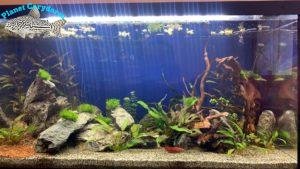
Recommended Tank and Water Conditions
- PH: 6.8-8
- Temp: 21c-27c (69.8f – 80.6)
- Tank Size:
- Absolute Minimum recommended: 30 Litre (8 US Gallon)
- Comfortable recommended: 50 Litre + (13 US Gallon +)
- Group Size: Min 3 but the larger the group the happier the fish. (Recommended 6+)
- Substrate: Fine natural sand
- Planted?: It is recommended that your aquarium is planted
- Temperament: Peaceful, Community
- Tankmates: Corydoras are very friendly fish and will not bother any fish including shrimp and snails. However, ensure the fish kept with them are not hostile to the Corydoras. Ensure the tanks mates are suited to the same temperature ranges and PH. Often kept with them are all kinds of Tetra and Plecs.
- Water Flow: Slow moving, this can mimic their natural habitat of small streams.
- Tank Cover: It is recommended that you have a lid on your aquarium as Corydoras are known to dart to the surface for Food or Air. Sometimes they can forget to stop and as such may jump. This is unlikely but it is always better to safe.
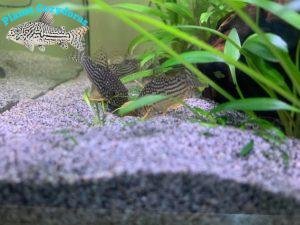
Diet
Corydoras will eat a wide range of food from sinking pellets to live/frozen food. They are especially fond of daphinia and blood worms but as with all fish, variety is key to a healthy diet.
Feeding morning and night is recommended.
When you are away it best not to feed the corydoras they will be quite happy for 2 weeks with out food. Slowly reintroduce food on your return.
More information on the diet for your fish can be found here.
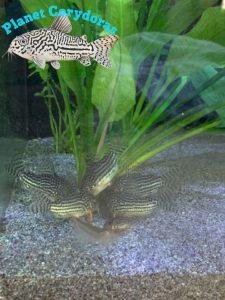
Behaviour and Temperament
General behaviour:
Cory catfish are famous for their sweet and peacful temperament, which is one of the main reasons they’re so popular with aquarists. They spend the majority of their time peacefully foraging around the bottom of the aquarium looking for food. They can also be seen, staring out the tank in a group seemingly plotting something sinister or rolling their eyes at their human friend in mock dismay. They will generally ignore or leave all other tank mates alone and can live peacefully with a wide range of tank mates because of this.
They will be seen cleaning the surfaces of wood, rocks and large leaved plants aswell, both searching for food and getting them ready for a potential egg laying spot.
They will also be seen darting to the surface for a gulp of air, which is natural as they can breath surface oxygen like this but should be watched as it can signal a lack of oxygen or other water issues.
Other prominent behaviours:
When a female wants to spawn she will release a hormone which will drive the males into a spawn frenzy. It can appear that males are fighting and get aggressive towards the female. This is natural but can be daunting when seen for the first time.
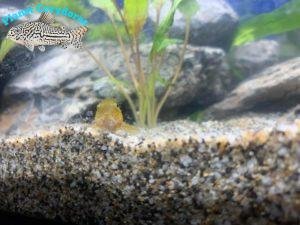
Common Diseases
Corydoras, Like all aquatic life are susceptible to a wide variety of ailments. As such, a list has been collated below of the common ailments. This list is by no means exhaustive.
- Ich (White spot).
- Fungal Infection.
- Nitrate Poisoning. (especially affecting their barbels)
- Red Blotch Disease
- Parasites
Medications for these can be found in our medications guide here.
